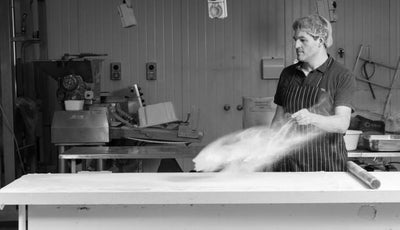
Making pasta could be described as a little bit of science, a little bit of art and a whole lot of flour! Yet the role that flour plays in producing quality pasta is often underestimated. Making pasta is our trade at Maria’s so we can’t ignore the power of flour. It’s our core ingredient – it gives our pasta colour, texture, elasticity and taste. We primarily use 3 different types of flour for our pasta products; we refer to them as plain, durum and spelt.
What’s the difference?
I’m so glad you asked! A quick Google search might give you a history lesson on ancient grains, espouse the health benefits of spelt, or you could find yourself in the middle of culinary-combat as passionate bakers argue the virtues of 00 versus all-purpose flour. So, I’m going to help you out and tell you how we roll here at Maria’s (see what I did there?). Just the important stuff - why we use different flours and when. Here’s the low-down, as we see it.
Plain Flour
We call it plain, but that’s a bit of a misnomer (and slightly unkind) because this flour is an awesome little work-horse. It’s made from white, hard-grained wheat but it’s not all-purpose flour - it’s more like “00” flour. The “00” refers to how finely it’s ground – and this stuff is fiiiine baby! It’s super-fine particles and delicate texture makes it perfect for pasta making because it rolls out so well. It is higher in starch and lower in protein than durum or spelt, but with 11g of protein per 100g of flour, it is still a moderately high-protein flour.
We use it to make our Plain Pasta – commonly used as whole sheets in lasagne, or cut to size for spaghetti, fettucine, linguine etc.

Durum Flour
Durum flour is derived from prime hard semolina wheat and is the Protein King of wheat flours with about 14g of protein per 100g of flour. It makes a strong and balanced pasta dough, characterised by it’s bright, golden colour and robust nature. It’s the preferred pasta of our food service customers – restaurants and cafes love it because it can be pre-cooked and then quickly refreshed without becoming gluggy or breaking. Life is way too short to eat gluggy pasta (or drink bad wine). It’s glorious colour, great taste and forgiving nature make it a favourite of home cooks too.
Our Durum Pasta is our best-seller as whole pasta sheets or cut pasta. We also use durum flour in our filled pasta range. We blend the durum with a coarser-grained plain white flour (referred to as “sharp”) that is higher in starch and lower in protein. This secondary flour is the same one we use for dusting our fresh cut pasta so that it doesn’t stick together. Our special blend is the perfect combo of texture, taste and importantly, elasticity. Pasta used for pasta shapes, such as ravioli and tortellini needs to be slightly elastic so that it can be moulded and shaped without breaking. This is one of the many good reasons to buy pasta from small-batch pasta makers like us. We know our stuff! You’ll taste our expertise at work in our ravioli, tortellini, pinzati, cannelloni and our famous, handmade jumbo agnolotti.

Spelt Flour
Spelt flour is derived from a subspecies of common wheat. It’s intensive to mill – requiring the firm outer husk to be removed, then roller-milling the inner kernel of grain and sieving out the bran. This results in lots of the nutrients being retained. It has a slightly nutty flavour, twice as much dietary fibre than plain flour, lower carbs and more protein too. Many people find that it is an easily digestible grain and it’s gained a lot of loyal fans since we started making it a couple of years ago. We use it to make our Spelt Pasta – commonly used as whole sheets in lasagne, or cut to size for spaghetti, fettucine, linguine etc.

Nutritional Info per 100g
Don't take my word for it! This chart compares the basic nutritional info for the flours we use at Maria’s. All of these flours contain gluten, so they are not suitable for people with coeliac disease or other gluten intolerances.
|
|
Plain 00 Flour |
Durum Semolina Flour |
Spelt Flour |
|
Energy (kJ) |
1464 |
1452 |
1420 |
|
Protein (g) |
11 |
14 |
12.1 |
|
Total Fats (g) |
1.6 |
1.3 |
2.1 |
|
Carbohydrate (g) |
70.1 |
66.6 |
61.6 |
|
Sugars (g) |
0.5 |
0.8 |
0.8 |
|
Starch (g) |
71.3 |
65.8 |
60.8 |
|
Dietary Fibre (g) |
3.2 |
4.1 |
7.4 |
|
Sodium (mg) |
3.7 |
4 |
3.5 |
Did you know that you can access the nutritional information for most foods from the Australian Food Composition Database?
One last thing…
Our pasta contains flour, filtered water and whole egg. Nothing else. Many cuisines around the world have a traditional dish made from the same 3 ingredients. So why is our ravioli not a dumpling? Why is our linguine not egg noodles? The difference is in the technique. More on that to come…





